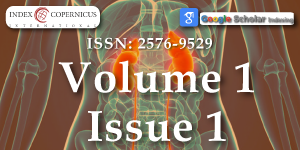Acute Tubulointerstitial Nephritis due to Phenytoin: Case Report
Main Article Content
Abstract
Introduction: Acute tubulointerstitial nephritis (ATIN) is an acute kidney injury (AKI) resulting from damage to the tubulointerstitial tissue due to infection, trauma, or use of medication. It is clinically non-specific.
Case: A teenager with multiple trauma, hospitalised after lowering of level of conscience, and convulsion fits. While in the emergency ward, he received: midazolam, fentanyl and phenytoin. The cranial and abdominal CT scans were normal. He was stable with no signs of shock, trauma or infection; he developed oliguria and serum creatinine (Scr) 1.7mg/dL), 12 hours after the admission. After 36 hours, Scr levels were at 3.4mg/dL and urea at 55mg/dL. He had AKI according to pRIFLE (66.2% reduction in clearance). After other causes of AKI had been ruled out, the possibility of ATIN was raised; the phenytoin was suspended and pulse therapy, with methylprednisolone, was promptly initiated. After the first pulse, there was already a decline in the creatinine and urea readings; 48 hours later: Scr at 2.2mg/dL and urea at 86mg/dL. Thirty days after being discharged from hospital, the patient was in good health and had full restoration of kidney function.
Discussion: The singularity of this report relies on the rarity of ATIN secondary to the use of phenytoin and also in the importance of recognizing this aetiology as being one of the origins of AKI.
Conclusion: Early diagnosis allows the reversal of AKI through suppression of treatment with phenytoin and introduction of corticosteroid therapy, when necessary.
Article Details
Copyright (c) 2017 Bresolin NL, et al.

This work is licensed under a Creative Commons Attribution 4.0 International License.
Freire KM, Bresolin NL, Farah AC, Carvalho FL, Góes JE. Acute kidney injury in children: incidence and prognostic factors in critical ill patients. Rev Bras Ter Intensiva. 2010; 22: 166-174. Ref.: https://goo.gl/mE7zPK
Andreoli SP. Acute kidney injury in children. Pediatr Nephrol. 2009; 24: 253-263. Ref.: https://goo.gl/sHjdgS
Romano TG, Tierno PF. Acute renal injury in polytrauma patients. J Bras Nefrol. 2013; 35: 48-56. Ref.: https://goo.gl/8O9mkf
Subat-Dezulovic M, Slavić I, Rozmanić V, Persić M, Medjimurec B. Drug-induced acute tubulointerstitial nephritis: A case with elevated urinary cadmium. Pediatr Nephrol. 2002; 17: 382-285. Ref.: https://goo.gl/14eyLF
Ulinski T, Sellier-Leclerc AL, Tudorache E, Bensman A, Aoun B. Acute tubulointerstitial nephritis. Pediatr Nephrol. 2012; 27: 1051-1057. Ref.: https://goo.gl/KH4QWI
Rastegar A, Kashgarian M. The clinical spectrum of tubulointerstitial nephritis. Kidney Int. 1998; 59: 313-327. Ref.: https://goo.gl/o0Dh8a
Oliveira MCD, Miguel CN. Atualização em insuficiência renal: nefrite túbulo-intersticial aguda. J Bras Nefrol. 2000; 22: 260-276.
Kodner CM, Kudrimoti A. Diagnosis and management of acute interstitial nephritis. Am Fam Physician. 2003; 67: 2527-2534. Ref.: https://goo.gl/NqZBhe
Tong JE, Howell DN, Foreman JW. Drug-induced granulomatous interstitial nephritis in a pediatric patient. Pediatr Nephrol. 2007; 22: 306-309. Ref.: https://goo.gl/PWGIOw
Pannu N, Nadim MK. An overview of drug-induced acute kidney injury. Crit Care Med. 2008; 36: 216-223. Ref.: https://goo.gl/DBl5kF
Bellomo R, Kellum JA, Ronco C. Acute kidney injury. Lancet. 2012; 380: 756-766. Ref.: https://goo.gl/v4Xjl3
Sheth KJ, Casper JT, Good TA. Interstitial nephritis due to phenytoin hypersensitivity. J Pediatr. 1977; 91: 438-441. Ref.: https://goo.gl/ldVhbm
Hyman LR, Ballow M, Knieser MR. Diphenylhydantoin interstitial nephritis. Roles of cellular and humoral immunologic injury. J Pediatr. 1978; 92: 915-920. Ref.: https://goo.gl/KcbDmS
Hoffman EW. Phenytoin-induced interstitial nephritis. South Med J. 1981; 74: 1160-1161. Ref.: https://goo.gl/WjsnGS
Matson JR, Krous HF, Blackstock R. Diphenylhydantoin-induced hypersensitivity reaction with interstitial nephritis. Hum Pathol. 1985; 16: 94-97. Ref.: https://goo.gl/8VoAqE
Ram R, Swarnalatha G, Prasad N, Prayaga A, Dakshina Murthy KV. Granulomatous interstitial nephritis after prolonged use of Phenytoin. Saudi J Kidney Dis Transpl. 2009; 20: 131-133. Ref.: https://goo.gl/L4MLjy
González E, Gutiérrez E, Galeano C, Chevia C, de Sequera P. Early steroid treatment improves the recovery of renal function in patients with drug-induced acute interstitial nephritis. Kidney Int. 2008; 73: 940-946. Ref.: https://goo.gl/inOP2n
Perazella MA and Markowitz GS. Drug-induced acute interstitial nephritis. Nat Rev Nephrol. 2010; 6: 461-470. Ref.: https://goo.gl/V4NF1i
Praga M and Gonzalez E. Acute interstitial nephritis. Kidney Int. 2010: 77: 956-961. Ref.: https://goo.gl/FPN5v2
Lim AKH. Haematuria and acute kidney injury associated with warfarin anticoagulation. Gen Med (Los Angel) 2013; 1: 105. Ref.: https://goo.gl/8s2Ekq
Fogazzi GB, Ferrari B, Garigali G, Simonini P, Consonni D. Urinary sediment findings in acute interstitial nephritis. Am J Kidney Dis 2012; 60: 330-332. Ref.: https://goo.gl/8lvGu6
Rossert J. Drug-induced acute interstitial nephritis. Kidney Int. 2001; 60: 804-817. Ref.: https://goo.gl/mnlISR
Patzer L. Nephrotoxicity as a cause of acute kidney injury in children. Pediatr Nephrol 2008; 23: 2159-2173. Ref.: https://goo.gl/1o0Hok





